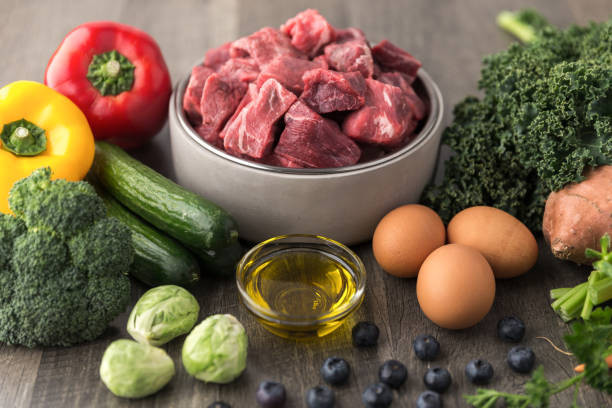views
Sustainable Protein Sources in Latin America Pet Food Market

Introduction:
The Latin America Pet Food Ingredients Market has experienced significant growth in recent years, driven by the rising pet ownership rates, increasing disposable incomes, and a growing demand for high-quality, sustainable pet food. As consumers become more conscious of their pets’ health and the environmental impact of food production, there is a shift towards more sustainable and ethical ingredients in pet food formulations. One of the key areas where sustainability is making a significant impact is in the choice of protein sources used in pet food products.
In Latin America, the shift towards sustainable protein sources is being driven by several factors, including environmental concerns, the growing demand for plant-based and alternative proteins, and the desire to reduce the ecological footprint of pet food production. This article explores the role of sustainable protein sources in Latin America’s pet food market, highlighting the key trends, benefits, and innovations in the industry.
The Growing Pet Food Market in Latin America
Latin America is home to a large and diverse pet population, with pets being an integral part of families and communities. The pet food industry in the region has experienced robust growth over the past decade, driven by the increasing demand for premium, healthy, and sustainable pet food options. As pet owners become more knowledgeable about the nutritional needs of their pets, they are seeking out foods that provide high-quality ingredients, particularly proteins that are both nutritious and environmentally friendly.
The increasing focus on sustainability is not just a trend in pet food but also in the broader food industry, where consumers are seeking products that align with their environmental values. This shift towards sustainability has led pet food manufacturers to explore alternative protein sources that are not only good for pets but also better for the planet.
Sustainable Protein Sources: A Solution to Environmental Challenges
Protein is a fundamental ingredient in pet food, as it is essential for growth, muscle development, and overall health. Traditionally, animal-based proteins such as chicken, beef, and fish have been the primary sources of protein in pet food formulations. However, the environmental impact of animal agriculture, including deforestation, water usage, and greenhouse gas emissions, has raised concerns about the sustainability of conventional protein sources.
As a result, the pet food industry in Latin America is increasingly turning to alternative protein sources that offer a more sustainable solution. These alternatives include plant-based proteins, insect proteins, and alternative animal proteins, each of which presents an opportunity to reduce the environmental footprint of pet food production.
Plant-Based Proteins
Plant-based proteins are gaining traction in Latin America’s pet food market as a sustainable alternative to animal-based proteins. Plant proteins such as peas, lentils, chickpeas, quinoa, and soy are rich in essential amino acids and can provide the necessary protein requirements for pets. Additionally, plant-based proteins have a significantly lower environmental impact compared to animal proteins. The production of plant-based proteins requires fewer natural resources such as land, water, and energy, and generates fewer greenhouse gas emissions.
Incorporating plant-based proteins into pet food formulations offers several benefits. Not only do they contribute to more sustainable production practices, but they also cater to pet owners who are seeking vegan or vegetarian options for their pets. The demand for plant-based pet food is particularly high among owners of pets with food allergies or sensitivities to animal proteins. Furthermore, the use of plant-based ingredients can be a selling point for eco-conscious consumers who are looking to reduce their pets’ environmental impact.
Insect Proteins: A Growing Trend
Insect protein is emerging as one of the most promising alternative protein sources in Latin America’s pet food market. Insects such as crickets, mealworms, and black soldier fly larvae are highly nutritious, rich in protein, essential fatty acids, vitamins, and minerals. Insects also have a much smaller environmental footprint compared to traditional livestock. They require significantly less land, water, and feed, and they produce fewer greenhouse gas emissions.
The benefits of insect protein extend beyond sustainability. Insects are also considered a highly digestible protein source for pets, making them suitable for pets with sensitivities or allergies to conventional proteins. Insects also contain a natural prebiotic effect that supports digestive health, which can improve the overall well-being of pets.
Latin America, with its rich biodiversity and agricultural heritage, has the potential to become a leader in insect protein production for pet food. The region’s favorable climate conditions allow for the mass production of insects, which can be cultivated in an environmentally sustainable manner. As a result, insect protein is poised to become a key component of Latin America’s pet food market, offering an eco-friendly and nutritious alternative to traditional animal-based proteins.
Alternative Animal Proteins
In addition to plant-based and insect proteins, there is growing interest in alternative animal proteins such as duck, rabbit, and even more novel options like alligator and kangaroo. These proteins are typically used in pet food formulations designed for pets with food allergies or intolerances to more common protein sources like chicken or beef. Alternative animal proteins also offer a more sustainable option for pet food production compared to conventional livestock farming.
For example, duck is considered a more sustainable protein because ducks require less water and feed than cattle or pigs. Similarly, other wild or non-traditional meats, such as venison or bison, may have a smaller environmental impact when sourced from ethical and sustainable farming practices.
As consumers become more aware of the environmental impact of their purchasing decisions, alternative animal proteins are gaining popularity in Latin America’s pet food market. These proteins not only provide a unique flavor profile for pets but also offer a more sustainable solution for pet food manufacturers looking to diversify their ingredient offerings.
The Role of Local Ingredients in Sustainable Pet Food
Another trend driving sustainability in Latin America’s pet food market is the increasing use of local ingredients. Many pet food manufacturers in the region are sourcing ingredients from local farms and suppliers to reduce the carbon footprint associated with transportation and supply chain logistics. By using locally grown and harvested ingredients, pet food producers can support local economies, reduce food miles, and minimize environmental impact.
In addition to providing a more sustainable option, local ingredients often have a unique cultural and nutritional value. For example, Latin American countries are home to a wide variety of native fruits, vegetables, and grains that can be used in pet food formulations. These include ingredients such as quinoa, chia seeds, sweet potatoes, and yucca, all of which are rich in nutrients and provide additional health benefits for pets.
Local sourcing also allows pet food manufacturers to ensure the quality and freshness of the ingredients used in their products. By partnering with local farmers and suppliers, manufacturers can establish strong relationships and maintain greater control over the sourcing process, ensuring that their products meet high standards for both sustainability and quality.
Consumer Demand for Sustainable Pet Food
The growing demand for sustainable pet food is not just a passing trend but a reflection of broader consumer shifts in attitudes toward sustainability. Latin American consumers, particularly in urban areas like São Paulo, Buenos Aires, and Mexico City, are becoming more environmentally conscious and are increasingly seeking products that align with their values. This includes pet food products that are made from sustainable ingredients, use ethical production methods, and reduce environmental impact.
Pet owners in Latin America are looking for transparency in the products they purchase, with many demanding to know where ingredients come from, how they are produced, and whether they are sourced sustainably. Brands that can clearly communicate their commitment to sustainability and ethical sourcing are likely to gain a competitive edge in the marketplace.
Furthermore, as the millennial and Gen Z demographics become the dominant pet-owning generations, the focus on sustainability will only intensify. These generations are more likely to prioritize ethical considerations in their purchasing decisions, including when it comes to pet food. Pet food manufacturers in Latin America that are able to cater to these values by offering products with sustainable protein sources will likely see increased demand for their products.
Conclusion
The shift toward sustainable protein sources in Latin America’s pet food market reflects a growing awareness of the environmental and ethical challenges associated with traditional livestock farming. As consumers demand more sustainable, healthy, and ethical options for their pets, the pet food industry in the region is evolving to meet these expectations. Plant-based proteins, insect proteins, and alternative animal proteins are gaining popularity as sustainable alternatives to conventional meat-based ingredients, offering numerous benefits for both pets and the planet.
As Latin America continues to embrace sustainability in its pet food industry, manufacturers are increasingly incorporating local, environmentally friendly ingredients into their formulations. This trend not only supports local economies but also reduces the carbon footprint of pet food production. With growing consumer demand for sustainable products, Latin American pet food manufacturers are well-positioned to lead the way in creating eco-friendly, nutritious pet food that meets the needs of both pets and their owners.






















Comments
0 comment